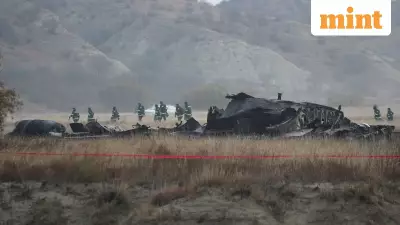
The United States has officially confirmed the successful completion of stockpile flight tests for its upgraded B61-12 nuclear gravity bomb, marking a significant milestone in the nation's nuclear modernization program. These crucial tests demonstrate the reliability and effectiveness of the enhanced weapon system that forms a critical component of America's strategic deterrent.
Details of the Successful Flight Tests
The National Nuclear Security Administration (NNSA) announced that the flight tests were conducted in collaboration with the US Air Force. These tests took place on October 25, 2023, at the Tonopah Test Range in Nevada, where two F-15E fighter aircraft from the 461st Flight Test Squadron successfully released the non-nuclear test assemblies.
According to the official statement, both test units were dropped from the aircraft and successfully demonstrated their performance capabilities. The tests validated the weapon's non-nuclear functions as well as the aircraft's capability to effectively deploy the system. This represents the first stockpile flight test of the B61-12 since the weapon achieved full production rate in November 2022.
Technical Enhancements and Strategic Importance
The B61-12 nuclear gravity bomb represents the latest iteration in the long-running B61 family of weapons, featuring significant improvements over previous versions. The upgraded bomb incorporates enhanced safety, security, and accuracy features that make it a more reliable and precise strategic asset.
Marvin Adams, NNSA's Deputy Administrator for Defense Programs, emphasized the importance of these tests, stating that they demonstrate the continued reliability of the nation's nuclear deterrent. The B61-12 life extension program is extending the service life of the existing B61 bombs by at least 20 years while improving safety and security features.
The modernization program addresses the aging of the existing nuclear stockpile while maintaining the weapon's performance characteristics. The B61-12 is designed to be compatible with various aircraft, including the B-2A Spirit bomber, F-15E, F-16C/D, and future platforms like the B-21 Raider and F-35A Lightning II.
Global Context and Future Implications
These successful tests come at a time of heightened global tensions and nuclear modernization efforts by multiple nations. The B61-12 program represents part of the broader US nuclear weapons infrastructure modernization that includes warheads, delivery systems, and production facilities.
The NNSA has highlighted that the B61-12 life extension program is essential for maintaining the credibility of the US nuclear deterrent and supporting extended deterrence commitments to NATO allies. The weapon's enhanced precision reduces collateral damage while maintaining strategic effectiveness.
With the completion of these successful flight tests, the United States moves closer to full deployment of the upgraded nuclear gravity bomb system. The program continues to progress according to schedule, with the weapon expected to gradually replace older versions in the nuclear stockpile over the coming years.
The successful demonstration of the B61-12's capabilities reinforces the technical expertise of the US nuclear security enterprise and ensures the continued reliability of the nation's nuclear deterrent for decades to come.





